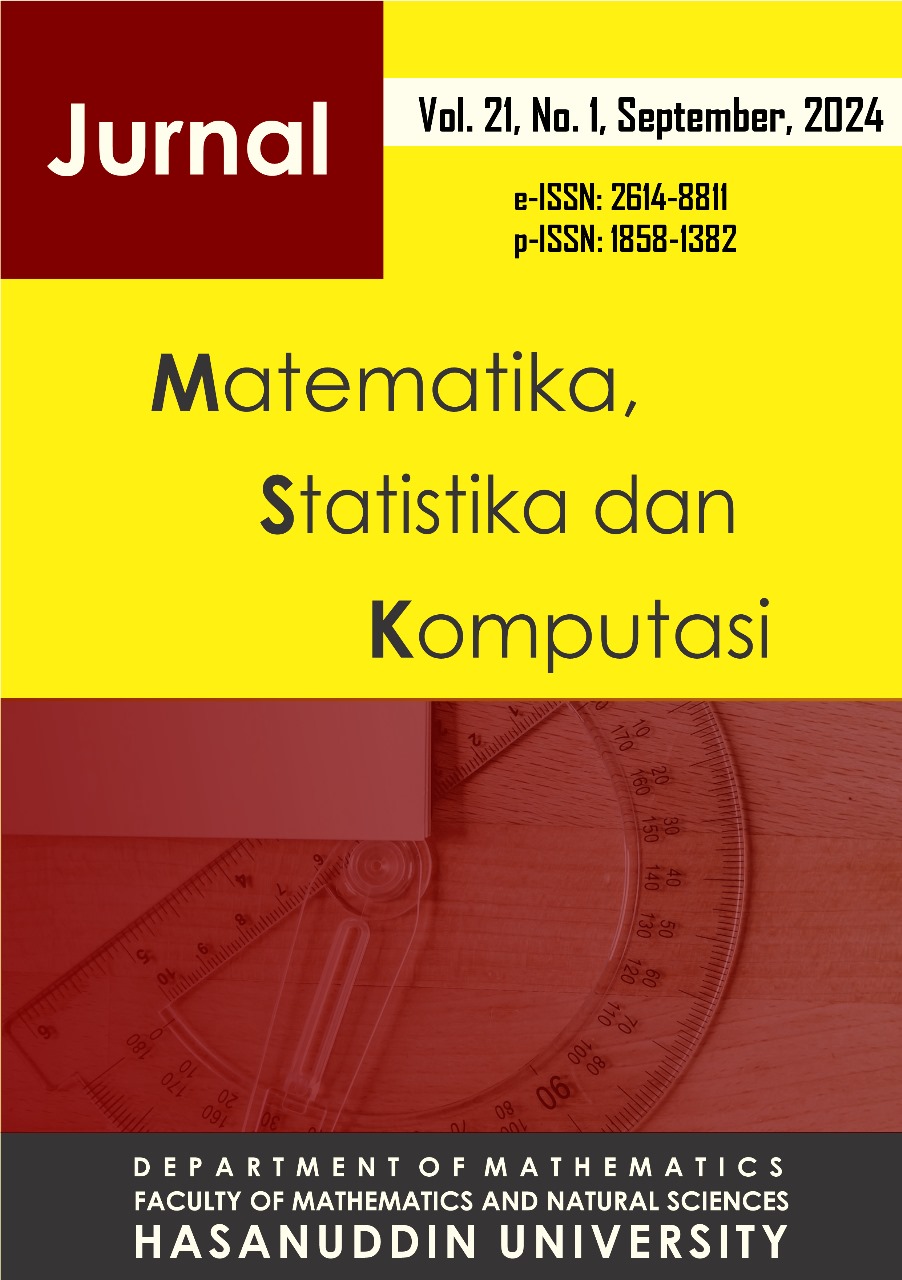Escalation of Human Resource Quality in National Health Resilience Through Estimating Multilevel Model Parameters with the Restricted Maximum Likelihood Approach to The 2019 UTBK Average
DOI:
https://doi.org/10.20956/j.v21i1.35781Keywords:
GCV, Multilevel Model, Restricted Maximum Likelihood, UTBK scoresAbstract
Multilevel modeling or Hierarchical Linear Modeling (HLM) is a statistical approach specifically used to analyze data with a two-level structure. This approach allows an understanding of the contribution of factors at both the individual and group levels to the response variable. One method commonly used in HLM is Restricted Maximum Likelihood (REML). REML is a parameter estimation method that is often applied in statistical models, especially linear models that incorporate random components. This allows more efficient parameter assessment compared to conventional estimation methods. In this research, multilevel model parameter estimation analysis was carried out using the limited maximum likelihood approach. The aim is to determine the multilevel linear regression model on the average UTBK score for health cluster study programs in 2019. This involves selecting the optimal node point based on the minimum Generalized Cross Validation (GCV) and identifying the factors that influence it. Predictor variables considered include interest and capacity of study programs at university level (Level-1), as well as the average UNBK and HDI scores at provincial level (Level-2). The findings of this research indicate that the most appropriate multilevel regression model is formed with three nodes with a minimum GCV value at Level-1 of 864.6593 and at Level-2 of 3.1816. At Level-1, the influencing factor is the interest variable and at Level-2 is the average provincial UNBK score in 2019 and the Human Development Index (HDI).
References
Briones, S. K. F. dkk., 2022. Factors Affecting the Students’ Scholastic Performance: A Survey Study. In Indonesian Journal of Educational Research and Technology, Vol. 2, No. 2, 97-102.
Destari, R.A., dkk, 2023. Evaluasi Kelayakan Peserta Ujian Tulis Berbasis Komputer di SMK Cerdas Murni. Jurnal Pengabdian Kepada Masyarakat, Vol 5, No.1, 20-25.
Dewi, Anastia., 2008. Estimasi Parameter. FMIPA, Universitas Indonesia
Goldstein, H., 2011. Multilevel Statistical Models, Fourth edition. John Wiley & Sons Ltd., London
Hamzah, I. F., & Akbar, Z. Y., 2018. Mengapa Millenials Memilih Jurusan Psikologi Pengambilan Keputusan dalam Memilih Jurusan Psikologi. SemNasPsi (Seminar Nasional Psikologi), Vol.1, No. 1, 113–120.
Hox, J.J., 2010. Multilevel Analysis: Techniques and Applications, Second Edition. Routledge, Great Britain.
Jainurakhma, J. dkk., 2023. Manajemen Pendidikan Tinggi Pasca Pandemi. Penerbit Buku Widina, Indonesia. https://repository.penerbitwidina.com/media/publications/559122-manajemen-pendidikan-tinggi-pasca-pandem-ec8f4379.pdf. [10 September 2023]
Jannah, M., dkk., 2020. Gambaran faktor yang melatarbelakangi mahasiswa Fakultas Kedokteran Universitas Muslim Indonesia Angkatan 2017, 2018 dan 2019 Memilih Program Studi Pendidikan Dokter. Molucca Medica, Vol.13, No. 1, 38–47.
Kemendikbud., 2019. Pemanfaatan Hasil Ujian Nasional untuk Meningkatkan Mutu Pendidikan. Puslitjakbud, Jakarta.
Kuswanto, H. dkk., 2022. Multilevel Nonparametric Regression Model with Truncated Linear Spline Estimator on Students' National Examination Scores. In International Journal of Academic and Applied Research (IJAAR), Vol. 6, No. 2, 77-81.
Malik, M. A., & Michoel, T., 2022. Restricted maximum-likelihood method for learning latent variance components in gene expression data with known and unknown confounders. G3, Vol. 12, No. 2, jkab410.
Meyer, K., 2023. Reducing computational demands of restricted maximum likelihood estimation with genomic relationship matrices. Genetics Selection Evolution, Vol 55, No1. 1-8.
Nufus, S. B. R., 2022. Abstract Multilevel Regression Analysis with Maximum Likelihood Method (Case Study: Population Density of Sumatera Selatan Province in 2020) [Skripsi]. Bandar Lampung: Universitas Lampung.
Nur, F., & Kurniawati, A., 2022. Meninjau Permasalahan Rendahnya Kualitas Pendidikan Di Indonesia Dan Solusi. In AoEJ: Academy of Education Journal, Vol. 13, No. 1, 1-13.
Priyana, E., 2020. Analisis Kelayakan Pembukaan Prodi Baru Terintegrasi Kebutuhan Pasar di Lingkungan Gresik dengan Pendekatan Statistik. Jurnal INTECH Teknik Industri Universitas Serang Raya, Vol. 6, No. 2, 132–140.
Rahmi, N. dkk., 2023. Implementation of the Reasoning Training Program for Optimizing the UTBK Test at SMAN 1 Parepare. Jurnal Pengabdian UNDIKMA, Vol. 4, No. 3, 701-707.
Raudenbush, S.W., dan Bryk, A.S., 2002. Hierarchical Linear Models: Applications and Data Analysis Methods. Thousand Oaks, CA: Sage.
Sholihah, I., & Firdaus, Z., 2019. Peningkatan Kualitas Sumber Daya Manusia melalui Pendidikan. In Jurnal Al-Hikmah, Vol. 7, No. 2, 33-46.
Susan, E., 2019. Manajemen Sumber Daya Manusia. Jurnal Managemen Pendidikan Islam, Vol. 9, No. 2, 952-962.
Widjanarko Otok, B., dan Vita Ratnasari, Ms., 2016. Estimasi Parameter Model Linier Hierarki dengan Pendekatan Generalized Least Square (Studi Kasus: Lingkar Perut pada Data Riskesdas dan Susenas Tahun 2013) [Tesis]. Surabaya: Institut Teknologi Sepuluh Nopember.
Yustika, D., & Sudarti, S., 2022. Analisis Regresi Linier Sederhana untuk Mengestimasi Pengaruh Kemampuan Self Regulated Learning terhadap Hasil Belajar Siswa menggunakan Model Pembelajaran Rasi. Jurnal Pendidikan MIPA, Vol. 12, No. 2, 294-297.
Downloads
Published
How to Cite
Issue
Section
License
Copyright (c) 2024 Jurnal Matematika, Statistika dan Komputasi

This work is licensed under a Creative Commons Attribution 4.0 International License.

This work is licensed under a Creative Commons Attribution 4.0 International License.
Jurnal Matematika, Statistika dan Komputasi is an Open Access journal, all articles are distributed under the terms of the Creative Commons Attribution License, allowing third parties to copy and redistribute the material in any medium or format, transform, and build upon the material, provided the original work is properly cited and states its license. This license allows authors and readers to use all articles, data sets, graphics and appendices in data mining applications, search engines, web sites, blogs and other platforms by providing appropriate reference.







